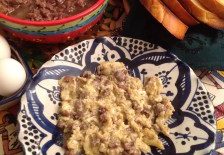The Disputed Dish- Knafeh
By: Waverly Nohr/ Arab America Contributing Writer
Knafeh is a dish that can be found throughout the Arab world. Although its main components are fairly standard, many countries have imparted their own twists on the traditional dish.
What is Knafeh?
Knafeh is a dish made from unripened cheese. The cheese is wrapped in shredded phyllo dough and dipped in simple syrup. Its flavors and textures are well balanced. Creamy cheese contrasts with the flakiness and subtle crispiness of the baked phyllo dough. The addition of pistachios in some cases offers yet another layer of crunch. In terms of flavor, one can find solace in the fact that a gratifying balance between sweet and savory satisfaction can be found in every bite.
Why is the preparation of Knafeh so disputed?
There is much debate on how the “ideal” Knafeh should be prepared. Some go as far as saying that Knafeh could easily be called the world’s most political food. Knafeh was first created in Nablus, a Palestinian city that is both a cultural and commerical locus. As Palestine is historically an area of major political conflict, the way its traditional dishes are altered as they leave its borders understandably face scrutiny. Even the way its name is spelled is sometimes a disputed topic among Arabs. Perhaps the most controversial and obvious conflict surrounding Knafeh is the Israeli claim that the dish hails most directly from their culture. Regardless of this claim, and the truth behind it, Knafeh has been tampered with greatly (the perceived positivity/ negativity of these alterations depend on who you are talking to) as it has traveled spatially throughout the Arab World.
What are some of the differences in Knafeh from country to country?
Knafeh’s travels through the Arab world can be thought of as a gastronomical game of telephone. In Turkey, Knafeh is formed with a metal mold, and the cheese that is used is more stringy and sweet than the one used in other countries. Turkish Knafeh is also topped with a whipped cream that is rarely found beyond its particular rendition. Lebanon uses a different kind of flour than other countries (semolina) and it is finished with a touch of citrusy orange syrup. Jordan uses the customary mozzarella cheese as its base, but introduces the dish to an extra dollop or two of ricotta. Additionally, Jordanians have been known to include an extra handful of raisins and crushed nuts to the top of their Knafeh. Even countries outside of the Arab world have taken a stab at creating their own versions of the dish. Culinary adventurers in Greece cook their Knafeh in copper plates and use a semisoft cheese that is unique to their interpretation. These many differences that span across the Arab world, and even outside of it, only serve to make the dish more nuanced and exploratory. It is worth noting that these traditional ways of making Knafeh are based more on pattern than they are on any sort of concrete rule or fact. A Jordanian cook may choose to finish their Knafeh with a brush of orange syrup, just as those in Lebanon may feel inclined to include ricotta in their family recipe. With the necessary component of respect and curiosity, cultural permeation brings exciting and new flavors to the forefront of the world that can be experienced by anyone who craves novel culinary delight.
The ingredients below are need to make a traditionally Palestinian Knafeh, which depicts how the dish was temporally first experienced. Refer to the link below for full instructions.
https://cleobuttera.com/middle-eastern/knafeh-naameh/
“INGREDIENTS
FOR THE SCENTED SUGAR SYRUP:
2 cups (400g) granulated sugar
1 cup (230g) water
Squeeze of lemon
2 teaspoons orange blossom water (more or less to taste)
1/2 teaspoon rose water (more or less to taste)
FOR THE CHEESE FILLING:
500g Shelal (or Shellala/Meshalela) cheese (preferably without black sesame)
300g Akkawi Tchiki Cheese
FOR THE KNAFEH CRUST (FARKEH):
375g kunafa (aka kataifi dough), fresh or frozen
1/3 cup plus 2 tablespoons (94g) melted ghee (or clarified butter
3 tablespoons (60g) scented sugar syrup
3 tablespoons (45g) water
2 tablespoons (30g) ghee or clarified butter, at room temperature, for cooking the knafeh
Ground pistachios, for garnish (optional)”
Check out our blog here!









